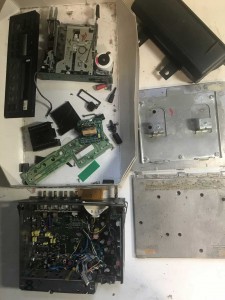I have a 5 year old IMac that recently started to act up in a most annoying fashion. Every couple of hours it would shut itself off, with absolutely no warning.
Right from the first occurrence, this felt like a power supply issue. I could power it back up, simply by unplugging the unit, waiting a few minutes, and turning it back on.
Research on the internet, revealed that others had similar issues, and also how to get inside the unit. One symptom of this failure is that the sys log showed the last restart was done to loss of power, not some kind of crash.
Knowing how expensive Apple service would likely be, I decided to look into fixing it myself. I carefully worked a putty knife between the display and the chassis to get it open. What a horrible design, it’s so bad that it’s hard to comprehend that Apple would ship something like that. I managed to crack one corner of the glass getting it open, but it wasn’t a fatal crack, and the display remains perfectly usable.
Anyway, I removed and examined the power supply, looking for the telltale signs of a damaged component, but couldn’t find anything obviously wrong. I decided to reassemble the unit, hoping that perhaps one of the connectors was intermittent. I decided to use duct tape to reattach the screen, in case I might need to attempt something different, like replacing the power supply, altogether, in order to get the system fixed.
After powering up and running for a few days, the problem returned, so I knew it wasn’t a faulty connector. I decided to take one more look at the power supply before ordering a replacement. This time, I repeated the scan for obviously fried components, but found none. I did notice that the soldering on a few of the through hole components, just didn’t look that good. The solder job looked like the heat wasn’t enough to draw the solder down into the holes, so the solder was kind of balled up on the legs of these parts. Getting the heat right on a board like this, probably isn’t easy, as it contains a mix of small surface mount parts and through hole parts, that are connected to relatively large heat sinks.
I decided to reflow the solder on the suspect components and see if the system would work more reliably. I went ahead and took a shot at it and put the system back together (with duct tape). I’m still not sure if I fixed it, but three weeks later, I haven’t seen a reoccurrence of the random power off. However, it wouldn’t surprise me at all if putting up this post doesn’t cause an immediate reoccurance of the issue!



